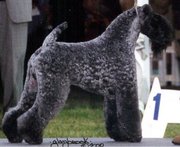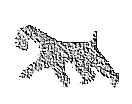
Like the other Irish Terrier breeds it is assumed that the Kerry Blue has been in the country for centuries, but, once again, because of its humble origins as a rat catcher and all-round farm dog, there are few, if any references to the breed before the 20th century. The first probable literary references to the Kerry Blue dates from 1847: the author describes a bluish slate coloured dog, marked with darker blotches and patches, and often with tan about the legs and muzzle. This blackish-blue Irish terrier was supposed to be prevalent in Kerry but it has been developed in other counties as well. The blue didn't make its first appearance on the show benches until 1913, and the Dublin Blue Terrier Club was formed in 1920.
The Kerry Blue became quickly so popular as a sort of mascot for Irish patriots that there were actually four clubs promoting its interests for a short time, and between 1922 and 1924 these clubs sponsored no fewer than six shows and six field trials. By 1928 this impressive balanced terrier with its beautiful soft blue coat became popular worldwide and its reputation as an excellent working and companion dog agreed with the breed assessment as "well nigh perfect".
Breed Standard
FCI Standard No. 3
Origin - Ireland 1.2.01
Utilisation:
Used in the hard job of tackling otters in deep waters, to engage badger underground and hunt vermin. A good watch dog and loyal companion.
Classification FCI: Group 3 Terriers
Section 1 Large and medium sizes Terriers. Without working trial.
Irish Classification: Terrier Group
GENERAL APPEARANCE
The typical Kerry Blue Terrier should be upstanding, well-knit and well proportionated, showing well developed muscular body with definite terrier style.
BEHAVIOUR / TEMPERAMENT
Terrier character throughout. The all important factor - expression must be keen and alert.
PHYSICAL CHARACTERISTICS
HEAD
Showing plenty of hair. Dogs should be stronger in head and more muscular than bitches.
CRANIAL REGION
Skull: Strong and well balanced
Stop: Slight
FACIAL REGION
Nose: Black, nostrils large and wide
Muzzle: The foreface should be of medium length
Teeth: Teeth large even and white, scissor bite. (level bite acceptable).
Jaws: Jaws strong and muscular (punishing jaw).
Mouth: Gums and roof dark
Eyes: Dark or dark hazel, medium in size and well placed, keen in expression.
Ears: Thin and not large, carried in front or close to the sides of the head, in a forward position, again to express the keen, sharp terrier expression.
NECK
Well proportioned, well set on shoulders and moderately long.
BODY
Back: Medium length, level
Loin: Moderate in Length.
Chest: Deep and of moderate width. Ribs well sprung.
TAIL
Thin, well placed and carried erect and gaily.
LIMBS
Forequarters:
Shoulders: Fine, sloping, well knit.
Forelegs: straight in front, bone good.
Hindquarters:Hindlegs well set under dog
Thighs: Muscular, well developed.
Hocks: Strong
FEET: Compact, pads strong and rounded, toe nails black.
GAIT / MOVEMENT: Good coordination, with legs parallel, forelegs reaching out and powerful drive in the hindquarters. When the dog is moving the topline should remain level and the head and tail should be carried high.
COAT
Hair:
Soft ,plentiful and wavy.
Colour:
Blue of any shade with or without black points. Black is permissible only up to the age of
18 months, as is also a shade of tan.
SIZE (Height & Weight)
Height at the withers:
Dogs: 18 - 19.5 inches (46 - 49.5cm)
Bitches: 17.5 - 19 inches (44.5 to 48 cm)
Weight:
Dogs: 33lbs to 40lbs (15 to 18kg)
Bitches: proportionately less.
FAULTS
Any departure from the foregoing points should be considered a fault and the seriousness with which the fault should be regarded should be in exact proportion to its degree.
·•Flesh Coloured Gums
·•Yellow or light coloured eyes
·•Roach back or hollow back
·•Narrow chest
·•Protruding elbows
·•Teeth undershot or overshot
·•White or bone coloured toe nails
·•Dewclaws on hind legs, or marks of their removal
·•Close, cow-hocked or stilted hind action.
·•Dogs whose heads or tails are held up by exhibitors or handlers should be penalised.
·•Hard, wire or bristle coat.
·•Any colour other than blue with the exception stated above.
N.B. Male animals should have two apparently normal testicles fully descended into the scrotum.
